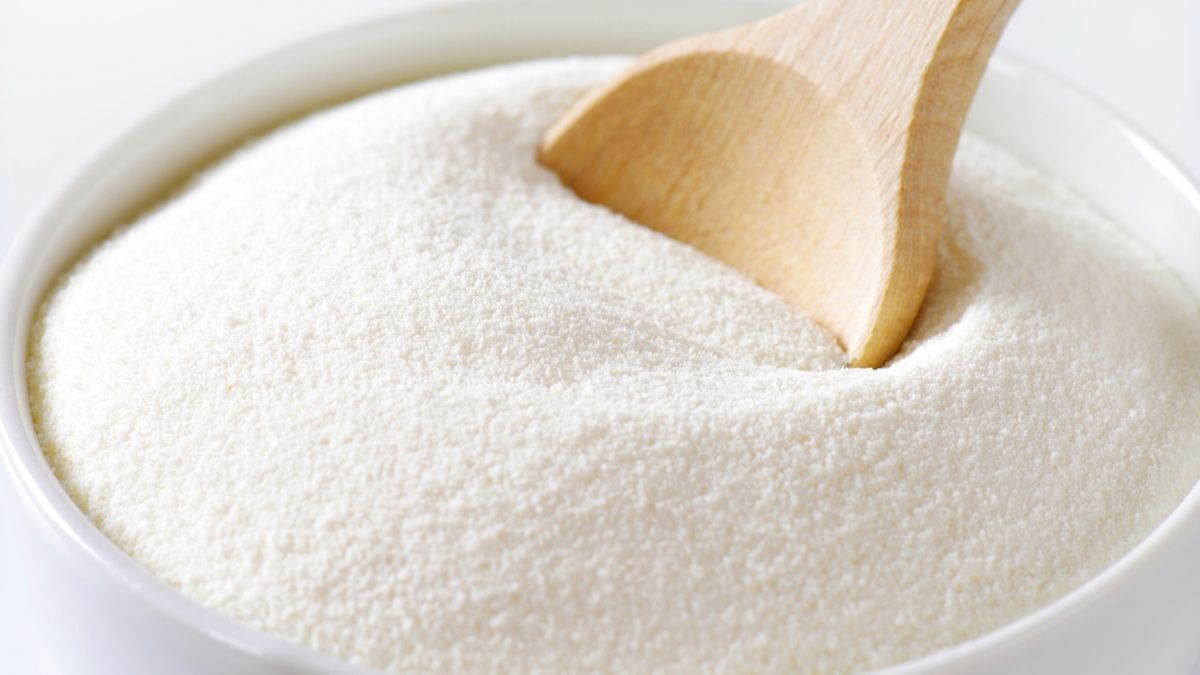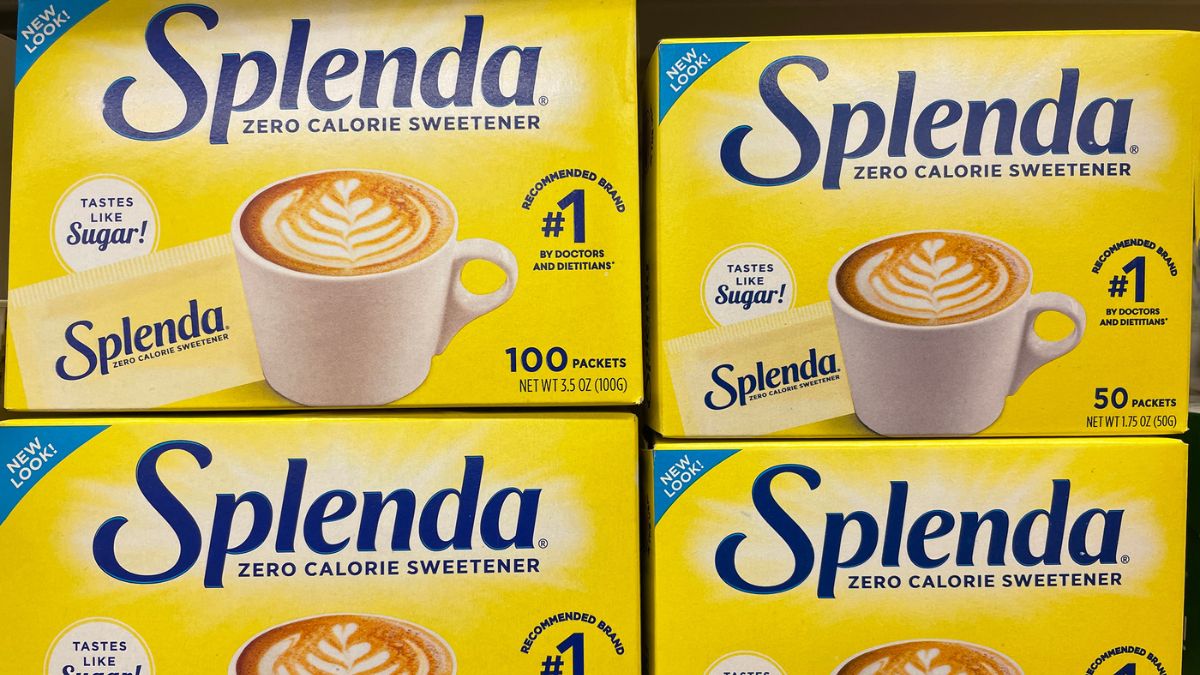Answer: No.

Powdered milk may sound cheap and unappealing at first compared to regular, fresh, liquid milk, but it has its uses for people, such as a more affordable substitute for real milk, longer shelf life, transportability, and added nutrients (fortified).
Powdered milk is still milk, dried and sourced from cows, and thus isn’t vegan.
Powdered milk is fundamentally “concentrated milk” in a dry, powdered form. Fresh milk is first pasteurized and then evaporated, dehydrating it to have less than 3% moisture. Dehydrating milk can be done via spray-drying, drum-drying, or freeze-drying. During the process, evaporation instantly occurs, leaving behind patches of dry milk powder.
Most powdered milk products you’ll see in groceries are dairy-based, but some, perhaps in the vegan/vegetarian aisle, are plant-based, such as powdered soy milk or powdered coconut milk.
Table of Contents
Powdered Milk
Process
Today, spray-drying is the most common way of making powdered milk. When fresh milk (skimmed, whole, buttermilk, or whey) is pasteurized, every particle is heated to 72°C (according to the FDA’s specified pasteurization time-temperature combinations), effectively destroying or reducing possible human pathogens and dehydrating the milk to about 50% milk solids.
Then, this pasteurized milk is sprayed as a mist through a heat chamber and lands on a hot surface, this heated environment instantly evaporates any remaining moisture from the milk layers down to 3%, and afterward, the dried powder is scraped off the surface.
Drum drying and freeze-drying are also known milk-drying processes, especially freeze-drying, which is slowly gaining popularity today as it allows the conservation of “essential” nutrients of milk that would otherwise be lost to spray-drying or drum drying. Drum drying is a less popular and less accepted process since it tends to “cook” milk and creates a “caramelized” taste in the powder; this isn’t present in both spray- and freeze-drying techniques.
In other words, the drying method and heat treatment in milk powder processing would greatly affect its flavor, solubility in cold water, and bulk density.
Purpose
Drying milk is generally for preservation. Powdered milk has less moisture, allowing it to have an exceptionally long shelf life by dismissing pathogenic or bacterial growth. Hence, powdered milk doesn’t have to be stored in a refrigerator like regular milk; it has less volume density and can be reverted to liquid milk by adding a 1/3 spoonful to a cup of water. These traits make it easy to store powdered milk and transport it from place to place without a refrigerator or the risk of liquid spills.
It’s also commonly used as a condiment, topping, or dry ingredient in baking and other desserts. In the Philippines, it’s topped on Iskrambol (ice scramble), a shaved ice dessert, for added sweetness and texture. In pastries and confectioneries, it helps thicken the mix better than thin, liquid milk and adds extra flavor, nutrients, and density. It’s also a medium for infant formulations with added “fortifications.”
Problem
Powdered milk may be loaded with health benefits and convenience perks, but still, it’s milk sourced from animals, which we prefer to avoid since dairy farming is a form of animal exploitation, and a mother cow’s nutritious milk solely belongs to her young.
Today, more people are becoming lactose intolerant; this is especially common in Americans and newborn babies, who feel stomach discomfort whenever they consume milk or other milk products (cheese, cream, yogurt, etc.). This inability to properly digest lactose due to a person’s genetic makeup causes them to turn to plant-based milk with no lactose.
Other people may also be allergic to dairy, most commonly children, and according to MayoClinic, milk allergy can also cause anaphylaxis (peanuts and tree nuts allergies also induce anaphylaxis), a life-threatening shock to the body that causes labored breathing, nausea, vomiting, and blood pressure drop. Lactose intolerance mustn’t be confused with true milk allergy, as while the former can cause slight to severe bowel strains, the latter causes internal and external symptoms such as diarrhea, vomiting, lip swelling, itching, and shortness of breath.
Others who are neither lactose-intolerant nor allergic to milk may opt for plant-based milk suited to their dietary needs, especially since natural whole milk is high in calories, fats, carbs, and sugars. Plant-based milk is more likely to have much fewer calories than those macronutrients.
Lactose intolerance, milk allergy, diet preferences, and the exponential growth of veganism, these factors opened a market for the production of plant-based milk and its much more convenient and versatile powdered forms.
Plant-Based Powdered Milk Options
Soy Milk Powder
Soy milk powder is perhaps the most basic and easiest to come by. Not only that, but it bears the most accurate nutritional similarity to real milk, more than any non-dairy alternatives. Interestingly, the process of making soy milk is the reverse of making powdered milk, in which solid soybeans are soaked in water overnight, ground, mixed with water, and boiled to a smooth consistency. It’s a solid-to-liquid process.
Now, soy milk powder isn’t made the same way as soy milk liquid; instead, it once again begins from solid soybeans. The soybeans are soaked and heated, then strained, dried, and ground to powder. The only difference between soy milk and soy milk powder is that the former is already mixed with water.
As for the nutritional values, from Healthline, a 1/4 cup of soy milk powder provides approximately 90 calories, 3.5 grams of fat, 8 grams of protein, 6 grams of carbs, and 4% of the DV for calcium. These values may vary depending on the soy milk powder you’re using.
Whereas a 1/3 cup of whole milk powder contains 159 calories, 8.5 g of fat (5.4 grams saturated), 31 mg cholesterol, 119 mg sodium, 426 mg potassium, 12 g carbs (12 g sugars), 8.4 g protein, and 22% of the DV for calcium.
Typically, whole milk powder contains more calories, saturated fats, cholesterol, sodium, carbs, and calcium, it’s only redeeming value. Soy milk powder takes the lead on protein and healthy fats against whole milk powder, clearly declaring which one’s the winner for health.
Now Foods Organic Soy Milk Powder is a great option because it’s USDA Organic approved and has 30 servings for $14.13. It’s only 0.5 g of saturated fat, 0 cholesterol, 10 mg sodium, and 1 g sugar per 4 tablespoon serving! It’s 100% vegan, too but processed in a facility that processes tree nuts, so be wary of allergies.
Kindly note that we are not affiliated with the product links we provide, so we don’t get any commissions based on the stuff you buy through our links. It’s all quality, honesty, and truth, my friend!
Coconut Milk Powder
Coconut milk powder is made similarly to whole milk powder, processed by spray-drying coconut milk or cream. However, coconut milk powder is much thicker than whole milk powder. Having almost double the calories and fats and half the protein content, coconut milk powder has a different use than being chugged straightaway.
The best use for coconut milk powder is as a cooking and baking substitute for whole milk powder, it makes every food heavier, creamier, and more flavorful. In Southeast Asian cuisine, coconut milk powder is commonly used for soups, broths, and sauces involving seafood and other vegetables.
While coconut milk powder is vegan, dairy-, and lactose-free, some brands may contain sodium caseinate derived from whole milk.
KOS Organic Coconut Milk Powder is vegan, keto, paleo-friendly, and all-natural. They also have two other coconut milk-based products: Vegan Protein Powder Chocolate and Plant-Based Protein Powder Vanilla. Although they’re more expensive, you only need a bit of it for your shakes, smoothies, coffee, and baked goods, and they’re deliciously creamy!
Coconut milk powder is by far the most expansive, not expensive, plant-based, dairy-free milk powder, so if you’re looking for one that suits your taste and preference, then you’re sure to find that here.
Cashew Powder
Any nut powder can easily substitute milk powder, but none gets as creamier, sweeter, and closer to milk powder as cashew milk powder. It’s very light that you can substitute it at a 1:1 ratio for drinks and recipes.
If you prefer cashew powder above others, you’re most likely into it because of its taste, but in comparison to soy milk powder, the latter still provides better nutrition. A 1/4 cup of cashew powder provides about 140 calories, 6 g fats, 3 g protein, and 20 g carbs.
While not as common as soy or coconut milk powder, cashew powder is available online.
Rice Powder
Also known as rice flour, rice powder is the safest bet for people with allergies. It’s vegan and advisable for people with allergies to dairy, soy, gluten, coconut, peanut, and tree nuts.
Another notable trait of rice powder is that it’s naturally sweeter than milk powder due to its sugars, which is why rice can also be fermented to make rice wine and has been popular for ages in East Asia.
This also makes rice powder great for desserts and a natural sweetener or creamer in coffee and tea. However, since it’s comprised mainly of sugary carbs, rice powder severely lacks fats, proteins, and other essential nutrients. If you’re opting for a fat-free powder, this one’s for you.
Again, not as common as the ones previously mentioned, but it certainly exists in some online stores.
Bottom Line
While milk powder continues to rule the grocery aisles, plant-based milk powders are surely on the rise, and people of all diets are becoming more and more open to these sustainable and environment-friendly substitutes that are healthier, tastier, and overall better than cruelly-obtained milk.
The only withholding factor of plant-based milk and milk powders is that they’re slightly more expensive than the traditional ones, but I daresay each box and pack is worth every dime. It’s for our health and our world’s well-being, people!
Thankfully, we are not alone in this conquest for uplifting plant-based milk as the best there is since many people prefer them for their diets and lifestyle. That only means that even in truth and general, plant-based milk wins the competition against dairy milk.




